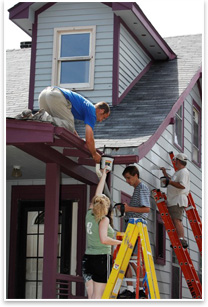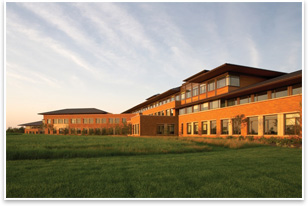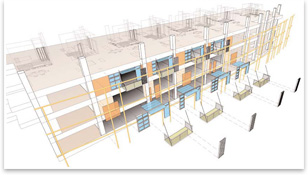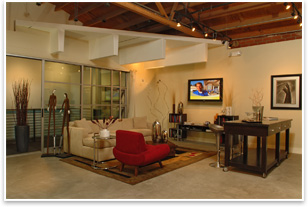Cuningham Celebrates 40 Years of Sustainable Design
by Tracy Ostroff
Contributing Editor
 How do you . . . make a difference while marking a milestone firm anniversary? How do you . . . make a difference while marking a milestone firm anniversary?
Summary: This summer, in celebration of its 40th anniversary, Cuningham Group Architecture convened all of its 200-plus employees from its five U.S. and two international offices to Minneapolis to team with Twin Cities Habitat for Humanity on its program, “A Brush with Kindness,” designed to revitalize and restore several homes in the Northwest quadrant of the city. To round out the celebration weekend, they also organized team-building events, compiled a 40-year retrospective and vision for the future, and introduced “Our Clients, Our Projects, Our Lives,” a mission statement that reaffirms the practice’s commitment to help revitalize the planet through environmentally responsible design.
 Cuningham Group shied away from a grandiose client party to mark the milestone anniversary, instead deciding to energize the staff with a community service project to which they could all contribute. In what their local paper called a “blitz of benevolence,” the Cuningham Group helped 10 low-income homeowners improve their properties through a Habitat for Humanity grant program. Cuningham has participated in Habitat programs before, but never had worked on 10 houses in one day, says Cuningham Group President Timothy Dufault, AIA. Cuningham Group shied away from a grandiose client party to mark the milestone anniversary, instead deciding to energize the staff with a community service project to which they could all contribute. In what their local paper called a “blitz of benevolence,” the Cuningham Group helped 10 low-income homeowners improve their properties through a Habitat for Humanity grant program. Cuningham has participated in Habitat programs before, but never had worked on 10 houses in one day, says Cuningham Group President Timothy Dufault, AIA.
At a staff party that evening, Dufault says he thought he would see a group of tired faces. Instead, Dufault found an excited group invigorated by the project. “It was a great team-building event. It wasn’t a fabricated exercise. It was doing something good for people who don’t have the means—whether physical or economic—to do it for themselves.” They headed out Friday morning and “accomplished everything on the list,” including painting, repairing trim, and other maintenance fixes. The architects and staff worked in teams, with everything well organized going into the Friday event.
With a purpose
The firm was born from a headquarters office in founder John Cuningham’s house in 1968. By 1971, Cuningham Group had already distinguished itself by winning its first award. John Cuningham recognized and emphasized the importance of sustainability from the outset, and this focus on green design has remained a constant throughout the firm’s development.
 On their anniversary weekend, the firm reaffirmed their Business Purpose Statement of who they are and what they do. “It is a self-motivator, rather than a marketing statement,” Dufault explains. That statement translates from values the Cuningham Group has held dear since its founding relating to a “triple bottom line,” Dufault says, of “people, profit, and planet.” It stems from a commitment to “sustaining communities, clients, and the environment as a whole.” On their anniversary weekend, the firm reaffirmed their Business Purpose Statement of who they are and what they do. “It is a self-motivator, rather than a marketing statement,” Dufault explains. That statement translates from values the Cuningham Group has held dear since its founding relating to a “triple bottom line,” Dufault says, of “people, profit, and planet.” It stems from a commitment to “sustaining communities, clients, and the environment as a whole.”
Dufault says: “We are a sustainable design firm at our core. We engage in the process of design in a way that inspires the person working on it, the client, and the users.”
With a vision
And they have been practicing architecture that way for 40 years. Back in 1968, John Cuningham received a grant from the Ford Foundation to help find ways to engage communities in the design process, Dufault says. His research led to a consensus planning model that back then (even just those 40 years ago) was a very different way of building community buy-in to a project.
The process John developed then wasn’t about the architect coming in with a design and a take-it-or-leave-it attitude, Dufault notes. “It was the process of working closely with the client and seeing the way they live on a daily basis.” Now the firm offers architecture, interior design, urban design, and planning services to the housing/mixed-use, retail/restaurant, hospitality, entertainment, education, civic, corporate, and worship markets.
 With a mission With a mission
The firm has taken this year to look both outside and within. Dufault says they are committed to the AIA 2030 carbon-emission reduction goals. They completed an energy audit of their own offices and determined that with just some subtle modifications they can improve their efficiency by 20 percent. Dufault says they are also a Natural Step company which means they have agreed to follow a framework for social and ecologically sustainability in a way that balances what is created and taken away from the Earth and what is given back in return.
Recent projects include a building for EPIC Systems Corporation, which is LEED® registered and is a 500,000-square-foot campus and separate learning center that uses extensive natural light and geothermal energy, vegetated roofs, and bioswales to capture contaminants in run-off. A local magazine named it the Best Green-Built Project and Project of the Year.
In residential work, the Cuningham Group designed Element, which comprises 50 live/work lofts in Marina del Rey, Calif., and is one of the few residential buildings in California constructed with a precast concrete moment frame. The precast concrete offers several advantages, the architects report, in that it keeps lofts cooler in the summer and warmer in the winter, maximizes ventilation, promotes construction efficiency, reduces the risk of mold and termites, has a 100-year lifespan, does not require costly maintenance, and is earthquake resistant.
 No other way No other way
Dufault has worked at the Cuningham Group for 16 years, and he says its “hard to imagine any other way.” He credits John Cuningham, FAIA, LEED-AP, for creating a culture of no strong ego. “We have grown and evolved in many different ways, but what has remained constant is a respect for the people who work with us.” With a turnover rate of less than 7 percent, that respect is mutual. He says they also have a lot of “boomerang employees,” or those whose “explorations have led them back to this place.”
For their future, Dufault says he expects continued growth in the organization. “The economy right now is challenging a lot of organizations. While we’re doing well, we need to be cognizant of what the economic challenges are.” He also forecasts greater international growth. He also looks forward to the ability to move forward to a “regenerative notion of design.” What he sees as a constant through the generational changes is the core values of the organization: dynamic design solutions that engage the client in a deeper exploration of their vision, their needs, and their business, resulting in environments that add value, build community, and enhance the lives of those who use them.
|


 How do you . . .
How do you . . . Cuningham Group shied away from a grandiose client party to mark the milestone anniversary, instead deciding to energize the staff with a community service project to which they could all contribute. In what their local paper called a “blitz of benevolence,” the Cuningham Group helped 10 low-income homeowners improve their properties through a Habitat for Humanity grant program. Cuningham has participated in Habitat programs before, but never had worked on 10 houses in one day, says Cuningham Group President Timothy Dufault, AIA.
Cuningham Group shied away from a grandiose client party to mark the milestone anniversary, instead deciding to energize the staff with a community service project to which they could all contribute. In what their local paper called a “blitz of benevolence,” the Cuningham Group helped 10 low-income homeowners improve their properties through a Habitat for Humanity grant program. Cuningham has participated in Habitat programs before, but never had worked on 10 houses in one day, says Cuningham Group President Timothy Dufault, AIA.
 With a mission
With a mission No other way
No other way